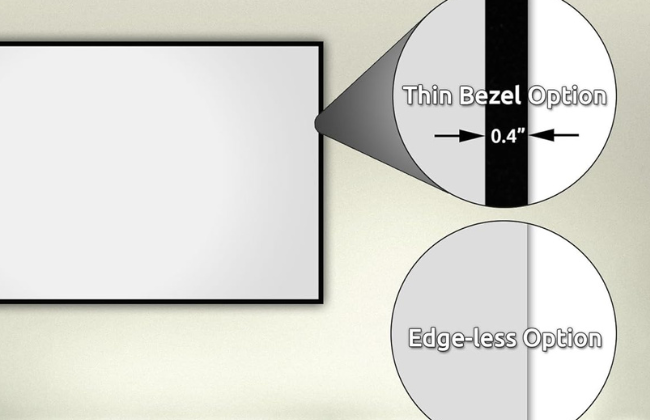What Is a Narrow Frame Screen?
- Frame Design: Features a narrow, sleek frame that is usually less than 1 inch (2.5 cm) wide, compared to traditional projection screens with wider frames. This design helps to minimize the frame's visual intrusion into the projected image.
- Frame Material: Typically made from materials like aluminum or high-density plastic, ensuring both durability and a slim profile.
- Fabric: The screen fabric is stretched tightly over the frame, often using a tensioning system to maintain a smooth and flat projection surface.
How to Use a Narrow Frame Screen
Installation:
- Mounting: Install the narrow frame screen on a wall or within a designated space according to the manufacturer’s instructions. Ensure that the screen is level and securely attached.
- Connecting to Equipment: Connect your projector to the screen using the appropriate cables. Ensure proper alignment and focus settings on the projector for optimal image quality.
Setup:
- Adjusting the Screen: Some narrow frame screens come with adjustable tensioning systems to ensure the fabric remains taut and smooth. Adjust the tension if necessary to remove any wrinkles or distortions.
- Projection: Turn on the projector and adjust its settings to fit the screen's dimensions. Fine-tune the image alignment to ensure it fits the screen perfectly.
Maintenance:
- Cleaning: Regularly clean the screen fabric with a soft, dry cloth or a mild cleaning solution to remove dust and maintain image clarity.
- Inspection: Periodically check the frame and fabric for any damage or wear. Ensure the screen remains taut and smooth.
Uses of a Narrow Frame Screen
Home Theaters: Provides a modern, sleek look that enhances the viewing experience without distracting from the projected image. Ideal for rooms where aesthetic appeal and image quality are important.
Conference Rooms: Useful for business presentations where a professional appearance is desired. The narrow frame minimizes distraction and maximizes the focus on the content being projected.
Classrooms: Helps in creating a clean and focused visual environment for teaching or presentations.
Commercial Spaces: Suitable for use in retail or other commercial environments where a sleek, modern look is preferred.
Fabric Used in Narrow Frame Screens
Matte White Fabric: Offers a wide viewing angle and good color accuracy, making it a popular choice for general-purpose use. It is designed to diffuse light evenly, providing a clear and consistent image.
High Contrast Grey Fabric: Enhances contrast and black levels by absorbing ambient light, which is useful in environments with some light present. This fabric helps to improve image quality in less-than-ideal lighting conditions.
Ambient Light Rejecting (ALR) Fabric: Designed to reject ambient light and enhance image contrast and color saturation. This type of fabric is beneficial in rooms with high levels of ambient light, such as living rooms or conference rooms.
Perforated Fabric: Used in screens designed for use with speakers behind the screen. The perforations allow sound to pass through while maintaining good image quality.
Conclusion
A narrow frame screen offers a modern, sleek solution for projecting images with minimal visual distraction from the screen’s borders. Its use in various settings—ranging from home theaters to professional environments—reflects its versatility and aesthetic appeal. The choice of fabric can significantly impact the viewing experience, with options like matte white, high contrast grey, ambient light rejecting, and perforated fabrics catering to different needs and environments.

